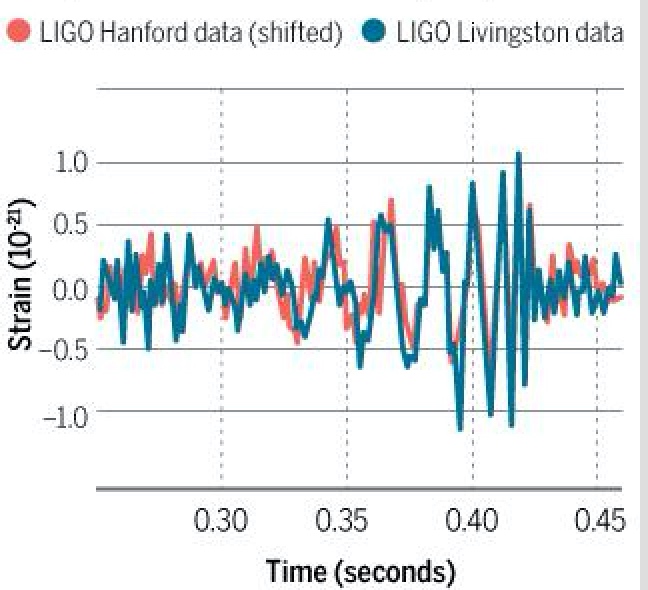What does the discovery of gravitational waves imply about dark matter and dark energy?
The first detection of gravitational waves results from a pair of merging black holes, and is yet another magnificent confirmation of the theory of general relativity. Einstein’s theory of general relativity has passed every test thrown at it during the last 100 years.
While the existence of gravitational waves was fully expected to be confirmed, the discovery took several decades and represents a technological tour de force. Detected at the two LIGO sites, one in Louisiana and one in Washington State, the main event lasted only 0.2 seconds, and was seen as a change of length in the “arms” of the detector (laser interferometers) of only one part in a thousand billion billion.

The LIGO detection of gravitational waves. The blue curve is from the Louisiana site and the red curve from the Washington state site. The two curves are shifted by 7 milliseconds to account for the speed-of-light delay between the two sites. Note that most of the power in the signal occurs within less than 0.2 seconds. The strain is a measure of proportional change in length of the detector arm and is less than 1 part in 10²¹.
Nevertheless, this is the most energetic event ever seen by mankind. The merger of two large black holes totaling over 60 times the Sun’s mass resulted in the conversion of 3 solar masses of material into gravitational wave energy. Imagine, there were 3 Suns worth of matter obliterated in the blink of an eye. During this brief period, the generated power was greater than that from the light of all of the stars of all of the galaxies in our known universe.
What the discovery of gravitational waves has to say about dark matter and dark energy is essentially that it further confirms their existence.
Although there is as of now no direct detection of dark matter, we infer the existence of dark matter by using the equations of general relativity (GR), in a number of cases, including:
- Gravitational lensing – Typically, a foreground cluster of galaxies distorts and magnifies the image of a background galaxy. GR is used to calculate the bending and magnification, primarily caused by the dark matter in the foreground cluster.
- Cosmic microwave background radiation (CMBR) – The CMBR has spatial fluctuation peaks (harmonics) and the first peak tells us about ordinary matter and the third peak about the density of dark matter. A GR-based cosmological model is used to determine the dark matter average density.
Dark matter is also inferred from the way in which galaxies rotate and from the velocities of galaxies within galaxy clusters, but general relativity is not needed to calculate the dark matter densities in such cases. However, results from these methods are consistent with results from the methods listed above.
In the case of dark energy, it turns out to be a parameter in the equations of general relativity as first formulated by Einstein. The parameter, lambda, (Λ) is known as the cosmological constant, and represents the minimum energy of the vacuum. For many years astronomers and cosmologists thought it might take the value of zero. However in 1998 multiple teams confirmed that the value is positive and not zero, and it turns out that dark energy has more than twice the energy content of dark matter. Its non-zero value is actually another stunning success for general relativity.
Thus the detection of gravitational waves indirectly provides further support for the canonical cosmological model ΛCDM, with both dark matter and dark energy, and fully consistent with general relativity.
References
http://www.sciencemag.org/news/2016/02/gravitational-waves-einstein-s-ripples-spacetime-spotted-first-time – ScienceMag article
B. P. Abbott et al. (LIGO Scientific Collaboration and Virgo Collaboration), Phys. Rev. Lett. 116, 061102 – Published 11 February 2016 – http://journals.aps.org/prl/abstract/10.1103/PhysRevLett.116.061102
NEW BOOK just released:
S. Perrenod, 2016, 72 Beautiful Galaxies (especially designed for iPad, iOS; ages 12 and up)


Leave a comment